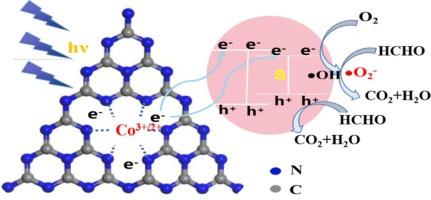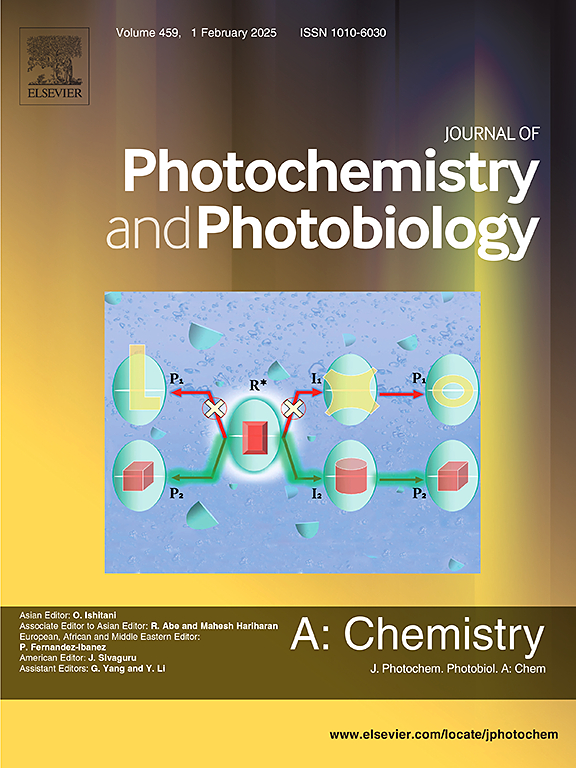从含 NH4SCN 的混合铵盐制备 g-C3N4 及其钴改性光催化降解甲醛的表征
IF 4.1
3区 化学
Q2 CHEMISTRY, PHYSICAL
Journal of Photochemistry and Photobiology A-chemistry
Pub Date : 2024-10-18
DOI:10.1016/j.jphotochem.2024.116097
引用次数: 0
摘要
本文旨在实现脱硫废液混合盐的高质量利用。通过热解含有硫氰酸铵、硫代硫酸铵和硫酸铵的混合物制备了 CN-MIX。此外,CN-MIX/Co-a 是通过浸渍-热解方法制备的,并进行了钴改性。以甲醛降解率为指标评估了光催化剂的性能,并测试了其稳定性。结果表明,与单盐制备的 CN 相比,CN-MIX/Co-a 的比表面积和孔体积分别增加了 1.53 倍和 1.44 倍。钴负载抑制了 CN-MIX 的热聚合,导致 (0 0 2) 晶体衍射峰强度降低。此外,CN-MIX/Co-a 在 2000-2200 cm-1 处的 CN 峰有所增加,从而产生了更多的光催化活性位点。可见光范围内的吸收边带从 429 纳米红移到 458 纳米,拓宽了光响应范围。光致发光(PL)图中的发射峰减小,从而降低了光生电子-空穴重组率。这种光催化剂增强了对甲醛气体的光催化降解能力,CN-MIX/Co-a 的降解率从 13.28% 提高到 99.2%。此外,在使用八个周期后,CN-MIX/Co-a 对甲醛的降解效率仍保持在 90% 以上,这表明它具有很高的稳定性。本文章由计算机程序翻译,如有差异,请以英文原文为准。

Preparation of g-C3N4 from mixed ammonium salts containing NH4SCN and characterization of its cobalt-modified photocatalytic degradation of formaldehyde
This paper aims to achieve high-quality utilization of desulfurization waste liquid mixed salt. CN-MIX was prepared through pyrolysis of a mixture containing ammonium thiocyanate, ammonium thiosulfate, and ammonium sulfate. Additionally, CN-MIX/Co-a was produced via an impregnation-pyrolysis method with cobalt modification. The performance of the photocatalysts was evaluated using the formaldehyde degradation rate as an index, and their stability was tested. The results indicate that the specific surface area and pore volume of CN-MIX/Co-a increase by 1.53-fold and 1.44-fold, respectively, compared to CN prepared from single salt. The cobalt loading inhibits the thermal polymerization of CN-MIX, leading to a reduction in the intensity of the (0 0 2) crystal diffraction peaks. Additionally, CN-MIX/Co-a exhibits an increase in the C![]() N peak at 2000–2200 cm−1, generating more photocatalytic active sites. The absorption sideband in the visible range red-shifts from 429 nm to 458 nm, broadening the photoresponse range. The emission peak in the photoluminescence (PL) diagram decreases, reducing the photogenerated electron-hole recombination rate. The photocatalyst demonstrates enhanced photocatalytic degradation of formaldehyde gas, with the degradation rate of CN-MIX/Co-a increasing from 13.28 % to 99.2 %. Furthermore, after eight cycles of use, the degradation efficiency of CN-MIX/Co-a for formaldehyde remains above 90 %, indicating high stability.
N peak at 2000–2200 cm−1, generating more photocatalytic active sites. The absorption sideband in the visible range red-shifts from 429 nm to 458 nm, broadening the photoresponse range. The emission peak in the photoluminescence (PL) diagram decreases, reducing the photogenerated electron-hole recombination rate. The photocatalyst demonstrates enhanced photocatalytic degradation of formaldehyde gas, with the degradation rate of CN-MIX/Co-a increasing from 13.28 % to 99.2 %. Furthermore, after eight cycles of use, the degradation efficiency of CN-MIX/Co-a for formaldehyde remains above 90 %, indicating high stability.
求助全文
通过发布文献求助,成功后即可免费获取论文全文。
去求助
来源期刊
CiteScore
7.90
自引率
7.00%
发文量
580
审稿时长
48 days
期刊介绍:
JPPA publishes the results of fundamental studies on all aspects of chemical phenomena induced by interactions between light and molecules/matter of all kinds.
All systems capable of being described at the molecular or integrated multimolecular level are appropriate for the journal. This includes all molecular chemical species as well as biomolecular, supramolecular, polymer and other macromolecular systems, as well as solid state photochemistry. In addition, the journal publishes studies of semiconductor and other photoactive organic and inorganic materials, photocatalysis (organic, inorganic, supramolecular and superconductor).
The scope includes condensed and gas phase photochemistry, as well as synchrotron radiation chemistry. A broad range of processes and techniques in photochemistry are covered such as light induced energy, electron and proton transfer; nonlinear photochemical behavior; mechanistic investigation of photochemical reactions and identification of the products of photochemical reactions; quantum yield determinations and measurements of rate constants for primary and secondary photochemical processes; steady-state and time-resolved emission, ultrafast spectroscopic methods, single molecule spectroscopy, time resolved X-ray diffraction, luminescence microscopy, and scattering spectroscopy applied to photochemistry. Papers in emerging and applied areas such as luminescent sensors, electroluminescence, solar energy conversion, atmospheric photochemistry, environmental remediation, and related photocatalytic chemistry are also welcome.

 求助内容:
求助内容: 应助结果提醒方式:
应助结果提醒方式:


